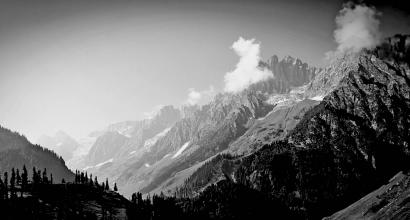In this article, the author contemplates upon why and how we practice our customs and then deliberates over how to celebrate the Kannada Rajyotsava—the state festival—in a meaningful way so that we can enjoy and enhance Kannada culture. The following is an English language translation of the original Kannada article. It is particularly valuable to contemplate on the suggestions given by the author now that the month of November has come to an end and there have been several celebrations to mark the State Day through the course of the past thirty days. (Translator's Note)
We look forward to yet another series of celebrations around Kannada Rajyotsava this November. It is by habit that our discussions, writings, thoughts, and contemplation turn to these topics. Many ridicule these celebrations as clichéd or as a ‘November fever.’ There is some substance in these criticisms too. A sensitive person can easily get disillusioned if this ‘celebration’ turns out to be a dry meaningless act fuelled by the synthetic enthusiasm of a social group. For such a person, this is as good as watching a nonbeliever performing a ritual in a lukewarm manner; it is another form of lip-sympathy. At the same time, the situation might have been worse had we ignored these mechanical reminders and stopped rekindling ourselves! I am reminded of the late Dr. Ha Ma Nayak’s writing about the annual Kannada Literary Festivals; in one of his articles he defended these "jatras" by saying that although such festivals have many shortcomings, they must not be abandoned for certain reasons.
If we feel that a certain action is meaningless to us, we should honestly and critically evaluate whether our mental state has truly surpassed the need of performing this action, or is it merely a culmination of our lack of enthusiasm masquerading as detachment. It is the harsh reality that most of the time our sluggishness is the reason behind our inaction and our abandoning of rituals. That is why the Bhagavad-Gītā (3.4) says:
न कर्मणामनारम्भात्
नैष्कर्म्यं पुरुषोऽश्नुते।
न च संन्यसनादेव
सिद्धिं समधिगच्छति॥
(One cannot achieve freedom from action by merely staying away from work. One does not become serene by merely giving up work.)
Even otherwise, common people are guided by well-established rules and regulations; they also need guidance as to when and how to follow rituals; and they yearn for the excitement associated with the celebration of fairs and festivals as well. The world is sustained only by the common folk. We are not, however, hell-bent on retaining all celebrations of all fests, including those that are rigid and mechanical. In fact, the barrenness of an action and the monotonous nature of performance are linked with the mindset of the performer. Any action by itself is inert. Its soulfulness or soullessness comes from the state of the mind of the performer. In the Kaṭhopaniṣad, Naciketa’s father Vājaśravas performed the Viśvajit yāga, a great ritual where the thought of ‘I’ (or ego) was to be sacrificed and one sought to reach the pinnacle of detachment. Vājaśravas, who lacked faith in the ritual, performed it in a dry and mechanical way by merely disposing off a few old cows. Śraddhā (devotion) by itself is never blind; rather, it is a blend of love and respect, knowledge and experience. Therefore, in the celebration of any festival like the Kannada Rājyotsava—pertaining to state, language, culture, society, land, or philosophy—when our sāttvika śraddhā (genuine devotion) awakens, even a monotonous ritual or a meaningless practice gains enrichment and fulfilment due to the grace of an enthusiastic performer. This will be comparable to Naciketa’s adventure of entering the den of death itself and coming out victorious by mastering both agnividyā and brahmavidyā (theoretical and practical aspects of the knowledge of Self). It is certainly possible to celebrate Kannada in a meaningful way.
Although the word ‘kannaḍa’ stands for the entire culture, ‘Kannada as a language’ helps in its self-expression and hence become the front face of our culture. As a consequence, often when we talk about ‘Kannada,’ the language Kannada takes the centre seat compared to other aspects of the society and culture. Barring language, we see many cultural similarities when compared to our neighbouring cultures, and language becomes a unique identity of the culture. At the same time, even within the same ambit of the region of Karnataka and the Kannada language, we see diverse cultural practices and usages. We should thus be cautious about the limits of considering language alone as the predominant feature of the whole culture. Culture does not even depend solely on language for expressing itself.
If that is the case, does language not deserve the importance it has earned in any culture? Indeed, it deserves the importance. In the context of culture, language has two dimensions –one for expressing subjective elements (pertaining to emotion) and another for communicating objective elements (pertaining to the world).[1] Language has the ability to nurture literature where the suggested meaning (vyañjana) takes prominence (as with music, dance, painting, and sculpture); it also has the ability to develop science (śāstra) and business where the designated meaning (abhidhā) and the implied meaning (lakṣaṇa) take prominence. On the one hand, language enjoys the company of various art forms where the line between sound and expression becomes thinner and thinner; in music, it merges into one i.e. the sound vibrations of śruti and laya are itself its expression as well as meaning. On the other hand, language is the facilitator for a purely materialistic pursuit such as business where sound should have unambiguous meaning; nothing else is expected from it. Language moves between these two extremes. This ability (or disadvantage) of language is not present in other fine arts or materialistic tools. Therefore, when we look at language in its totality, we should be extremely careful not to exaggerate or undermine its role. Exaggeration may lead to an overdose of emotion, resulting in childishness while undermining may lead to aridity of emotion, resulting in cynicism.[2] For all contemplation on such topics, we have to again take the refuge of language. Language is the vehicle of our thoughts. It shapes our thoughts and sometimes it becomes our thoughts! In order to direct our thinking deeper into our culture, we must have a good hold on our language. Therefore, to meditate upon the Kannada culture, first we need to have a command over the Kannada language. At the same time, we must not be under the illusion that the oneness that exists between Kannada culture and language also exists in the transactional dimension.[3] A practical thinker should accept both the possibilities of the ideal as well as the practical realities and strive for synchronizing actions with thoughts.
For now, we can focus our inquiry into the means of enhancing our linguistic skills for understanding the finer feelings of our culture. Those serious in the pursuit of filling their hearts with Kannada culture should start by focusing on Kannada grammar as well as etymology. When we approach our study from this angle, we can really appreciate why our ancestors stressed so much on grammar as a linguistic discipline. Grammar is an extraordinary science that explains how a sublime feeling transpires as a word, how advaita (non-duality) becomes dvaita (duality), and how energy becomes matter. Rather than reducing this to a mere technique or restricting it as a tool of anthropology, we should absorb this holistically as a vyāyāma-śālā (gymnasium) or yajña-śālā (place where the ritual is performed) for all our sensitivities. For this, we first should understand the heart of Kannada words. That naturally implies that our vocabulary should grow seamlessly.
Translated by Raveendra Holla from the Kannada original. Edited by Hari Ravikumar. The original essay is titled ‘ಕನ್ನಡನುಡಿ-ಕನ್ನಡಸಂಸ್ಕೃತಿ’ and appears in the anthology ಭಾಷಭೃಂಗದ ಬೆನ್ನೇರಿ.
Footnotes
[1] Those interested further in this topic can refer to Kuvempu’s article in ದಾರ್ಶನಿಕ ಕಾವ್ಯ ಮೀಮಾಂಸೆ, pp. 1-13
[2] Translator’s note: For example, we should be careful not to become cynical about our language just because English has become the medium of all jobs and businesses; we should also be careful not to chant the ‘Kannada for everything’ mantra just because its power of expression is superior when it comes to describing our culture.
[3] Translator’s note: Without doubt, there is an organic connection between language and culture; however, worldly affairs like business and trade are not necessarily tied to a single culture or language.











































